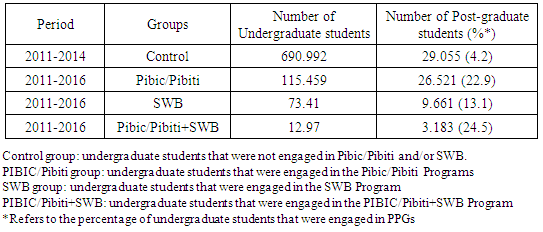-
Paper Information
- Paper Submission
-
Journal Information
- About This Journal
- Editorial Board
- Current Issue
- Archive
- Author Guidelines
- Contact Us
Education
p-ISSN: 2162-9463 e-ISSN: 2162-8467
2018; 8(4): 63-73
doi:10.5923/j.edu.20180804.01

Impact of the Policies of Scientific Initiation and Program Science without Borders in the Access of Students into Brazilian Postgraduate Programs
Adi Balbinot Junior1, 2, Andrea Carvalho Vieira1, Luciana Calabró2, Diogo Onofre Souza2
1Coordenação de Aperfeiçoamento de Pessoal de Nível Superior, CAPES, Brasília, DF, Brazil
2Program in Science Education, Universidade Federal do Rio Grande do Sul. RS, Brazil
Correspondence to: Luciana Calabró, Program in Science Education, Universidade Federal do Rio Grande do Sul. RS, Brazil.
| Email: |  |
Copyright © 2018 The Author(s). Published by Scientific & Academic Publishing.
This work is licensed under the Creative Commons Attribution International License (CC BY).
http://creativecommons.org/licenses/by/4.0/

This article presents a description of Brazilian federal policies directed to improve the scientific experience of undergraduate students: the Institutional Programs of Scientific Initiation Scholarships (PIBIC), Technological Development and Innovation Scholarships (PIBITI) and the Science without Borders (SWB). Then it discusses an outcome of these governmental actions: the admittance of students into Brazilian Postgraduate Programs. The article emphasizes that such policies greatly contributed to the admittance of students into Brazilian Postgraduate Programs of higher academic quality and international recognition, compared to students that did not participate in those Brazilian federal policies. It means that PIBC, PIBITI and SWB are relevant instruments for training and qualifying human resources to scientific, technological and educational activities in Brazil.
Keywords: Postgraduation program access, Science Without Borders, SWB, PIBIC, PIBITI
Cite this paper: Adi Balbinot Junior, Andrea Carvalho Vieira, Luciana Calabró, Diogo Onofre Souza, Impact of the Policies of Scientific Initiation and Program Science without Borders in the Access of Students into Brazilian Postgraduate Programs, Education, Vol. 8 No. 4, 2018, pp. 63-73. doi: 10.5923/j.edu.20180804.01.
1. Introduction
- The recognition of the strategic importance of science and the need to institutionalize the actions of incentive and foment to the scientific, technological and educational activities, led Brazil to create, in 1951, the National Council of Scientific and Technological Development - CNPq [1]. In this same perspective, the National Campaign for the Improvement of Higher Education Personnel (currently Capes) was created on July 11, 1951 [2], with the objective of "ensuring the existence of personnel specialized in quantity and quality sufficient to meet the needs of public and private enterprises that aim at the development of the country”. In Brazil, efforts to induce scientific activity by undergraduate students include the Scientific Initiation Programs (SIP) named “Program of Scientific Initiation Scholarships (PIBIC)” and “Program of Technological Development and Innovation Scholarships (PIBITI)”. As a result, in addition to receive more qualified training, these young people have high opportunities to be engaged in careers involving research in the University, as well as in public and private enterprises. These programs also contribute to increase the opportunity of undergraduate students get into the best qualified Brazilian postgraduate programs [7].Through these programs, undergraduate students are engaged into regular research activities, through planning and follow-up by PhD researchers. In this way, the scientific and technological vocation of university undergraduate students is improved and the teaching-research relationship at this level is ensured through the experience in the scientific activity and the engagement in the research promoted by the SIP. This program is consolidated in public and private universities through all country for more than two decades, led by the National Council for Scientific and Technological Development (CNPq). Recognition by the academic community of the positive impact of SIP in the formation of a distinguished profile of the students, which adds value to his/her academic formation, is well established [2].In turn, the institutional internationalization of Brazilian higher education began in the 1950s with the granting of the first scholarships abroad in 1953. This internationalization program has increasingly been a strong strategy in the Brazilian educational agenda, opening the Brazilian universities through two ways: bringing them to modernization and innovation, based on institutional mechanisms of international cooperation and another seeking the promotion of national development [8].In recent years, strategies to internationalize Brazilian Higher Education Institutions (HEIs) have gained significant increases through federal programs to strengthen academic mobility at undergraduate and postgraduate levels for studies and research as stated by the very relevant Brazilian institutional program Science without Borders (SWB) [2, 3] "internationalization more specifically in education is the process in which an international and intercultural dimension is integrated into the teaching, research and services of an educational institution." Thus, the implementation of an internationalization policy for higher education needs to contemplate the diversity of approaches in national policy actions aiming to promote internationalization of the universities [9]. In this context, PIBIC, PIBITI and SWB programs gain strategic relevance for qualifying academic professionals in Brazil and abroad.The PIBIC and PIBITI ProgramsThe Institutional Program for Scientific Initiation Grants (PIBIC) and the Institutional Program for Technological Development and Innovation Grants (PIBITI) are conducted by CNPq and they have as common objective an early scientific and technological training, with the participation of undergraduate students of Institutions of Higher Education (HEI). PIBIC started in 1988 and was furthermore regulated in 1993 [10]. The PIBIC aimed to involve Brazilian Universities for improving this program [11], providing the universities the opportunity to participate in the formulation of research policies for refining the undergraduation courses. It has a decentralized management model, being coordinated by HEI, in which there is an institutional committee composed of members of the three major areas of knowledge and is coordinated by a PhD researcher, preferably Research Productivity Scholarship, and has the Vice-Rector of Research and of Undergraduation, as the Institutional Representative of Scientific Initiation (RIC) with the CNPq. In this same model, in 2005, PIBITI was created for higher education and research institutions that work in the technological and innovation areas and that have a proven interaction with private and public companies, with the objective of contributing decisively to the formation and the engagement of undergraduate students in research, technological development and innovation activities. PIBIT aims to "stimulate technical and undergraduate students to develop and transfer new technologies and innovation" [12]. The program also intends to contribute to the insertion of undergraduate students into research activities related to the business sector and thereby to enhance the innovation capacity of companies in the country [13].The PIBIC allows that, annually (average between the years of 2012 and 2016), 23,761 undergraduate fellows participate in scientific research carried out in universities and in research centers, which occur on a large scale in the universities, most engaged in Postgraduate Programs. With a smaller number of scholarships (3,612), PIBITI follows the same path. In both programs, undergraduate fellows work in research projects of their PhD supervisors, either with basic or applied research; in applied research there is an involvement of technologic centers of HEIs or research centers, in which there is the participation of companies, especially in the generation of new technological processes and products and patents deposited in the country. Students may be awarded scholarships for both PIBIC and PIBITI throughout the undergraduate course. However, it is suggested that the initiation to science start from the third semester of graduation, when the students have had the opportunity to know the guiding teachers and research topics for which they have a greater affinity. When the Science without Borders (SWB) Program was created in 2011, it reflected the Brazilian federal government interest for giving those former undergraduate scholarships the opportunity to undertake an internship abroad in order to acquire knowledge and scientific maturity in the major scientific centers through the world. The Science Without Borders program is briefly described below.The Program Science Without Borders (SWB). Created in 2011, the Brazilian Science Without Borders program (SWB) [2] had very bold goals, which were much in line with the country's scenario at that time, that is, to provide training and qualification of young undergraduate students in worthy universities, educational institutions and foreign research centers with high scientific, professional and technological quality. In addition, SWB aims to attract from abroad young Brazilian talents working overseas and foreign researchers of high qualification in areas of science defined as priority by SWB, promoting the internationalization of national science and technology, stimulating research that generate innovation and, consequently, increasing the competitiveness of Brazilian scientific and technological culture. This goal has led to the significant expansion of the exchange and mobility abroad of Brazilian undergraduates, post-graduates, researchers and teachers. The SWB was then the achievement of the federal government's effort to raise Brazilian scientific capacity and increase the competitive performance of the national productive sector by increasing internationalization by the training of human resources for Science, Technology & Innovation, through the dissemination of policies, as can be seen in the document National Strategy for Science, Technology and Innovation 2016-2022 [1]: “International scientific cooperation is also essential for mobilizing competences in Brazil and abroad, contributing to the qualification of persons and to the promotion of R & D. The internationalization of Brazilian science, strengthened through the Science without Borders Program, should be guided by the direct access of researchers to works carried out in developed countries, by the global integration of these researchers and by the promotion of excellence research in Brazil”. This program has the potential to elicit important benefits associated with study abroad [15]. As we will describe, these scholarship grants have fostered a desire in students to pursue graduate education, resulting in an increase of graduate students in the STEM fields in Brazil. Throughout its four-year call for proposals, the program has provided 101,446 scholarships [14], of which 18,116 are funded by private resources and the remainder by the federal public budget allocated to the funding agencies executing the program - Capes and CNPq, totalling an investment of R$ 13.5 billions.Brazilian Postgraduate Programs (PPGs) – Strategies of national PPGs evaluation 1. Brazilian Postgraduate Programs (PPGs). CAPES is a federal agency devoted to the development of Post graduation in Brazil. It was created in 1951, with the responsibility of implementing, evaluating and financing the Postgraduate Programs (PPGs) throughout Brazil (2). Data from 2018 indicate that there are in Brazil 122,295 postgraduate students: 76,323 are from an academic master's degree, 4,008 from a professional master's degree and 41,964 from a Ph.D. degree. These students are registered in 4,175 Brazilian Postgraduate programs (Masters/Doctorate) [5]. These numbers reflect an intense increase during the last years in the number of postgraduate students in Brazil that have completed their postgraduate studies (Fig. 1) Consequently, there is a huge effort on the part of CAPES, the federal agency responsible for the creation and evaluation of PPGs, to keep PPGs at a high scientific levesl and also to propose the creation of new PPGs. Considering the number of PPGs and postgraduate students, this CAPES task has become extremely relevant for the scientific development of Brazil and for the training of qualified professionals in the various areas of science, technology, education and innovation. Accordingly, the National Postgraduation Plan - 2011-2020 [6], the Brazilian Postgraduation policy aims to improve the quality of the PPGs, to reduce the Brazilian geographical asymmetries, to induce the conception of a new agenda of re-search and to promote the internationalization of Brazilian Universities activities.
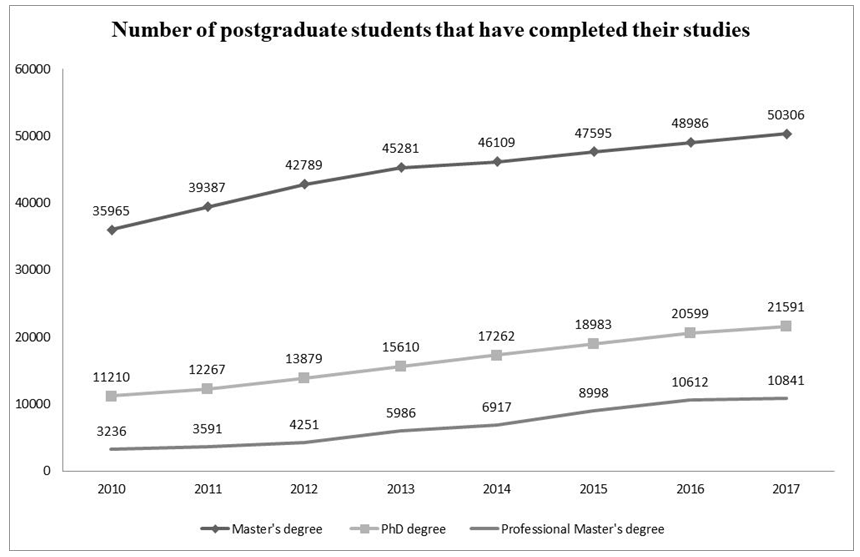 | Figure 1. Number of postgraduate students that have completed their studies (2010-2017) |
2. Methodology
- In order to analyze whether the scientific policies in Brazil involving undergraduate students (Pibic, Pibiti and SWB) were programs capable of qualifying undergraduate students to access PPGs with higher qualification (grades 6 and 7, in this study we carried out a work of identification of these students, mapping information about the undergraduate courses in areas of knowledge considered priority areas by SWB. We then evaluated whether undergraduate students who participated in the Pibic and Pibiti and/or SWB programs actually could be admitted by PPGs with grades 6 and 7 at a rate higher than undergraduate students that did not participate in any of these 3 programs. Table 1 summarizes the information of the groups of undergraduate students, the records used and the temporality adopted for the analysis.
|
3. Results Analysis
- When applying the methodology informed in the previous section on the available bases, it was possible to obtain the percentages of the access into the Postgraduate Programs and to perform analyses on the influence of Pibic/Pibiti and/or SWB programs on this access. The numbers in parentheses in figures 2 to 11 refer to the total number of Postgraduate Programs in each grade (from 3 to 7).Firstly, we performed an analysis based on the overall data, considering the distribution of the students accessing the Postgraduate Programs, without distinction of the areas of knowledge. It can be observed in all groups that most students accessed Postgraduate Programs with score 4. However, there is an interesting movement to observe: in Postgraduate Programs with score 3 (the lower score) the higher percentage of access was from control group, while in Postgraduate Programs with score 7 (the higher score) the higher percentage of access was from Pibic/Pibiti + SWB (Figure 1).
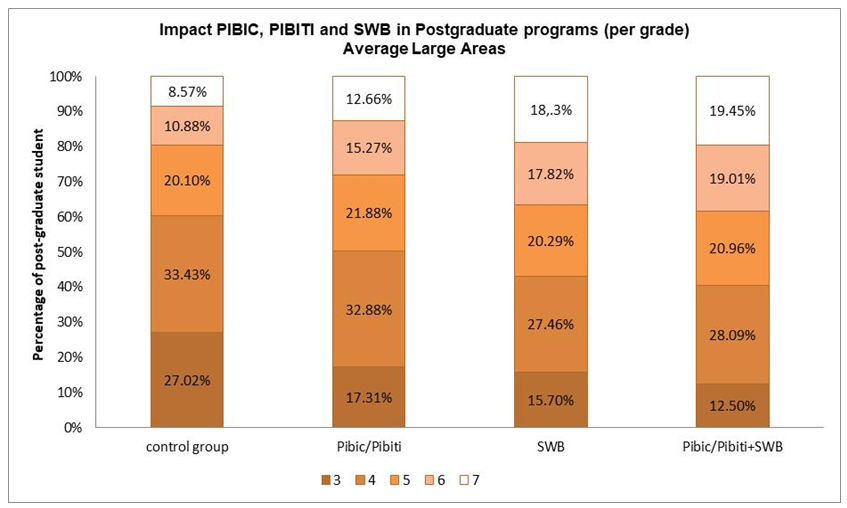 | Figure 2. Percentage of students accessing the Graduate Programs: all Great Areas |
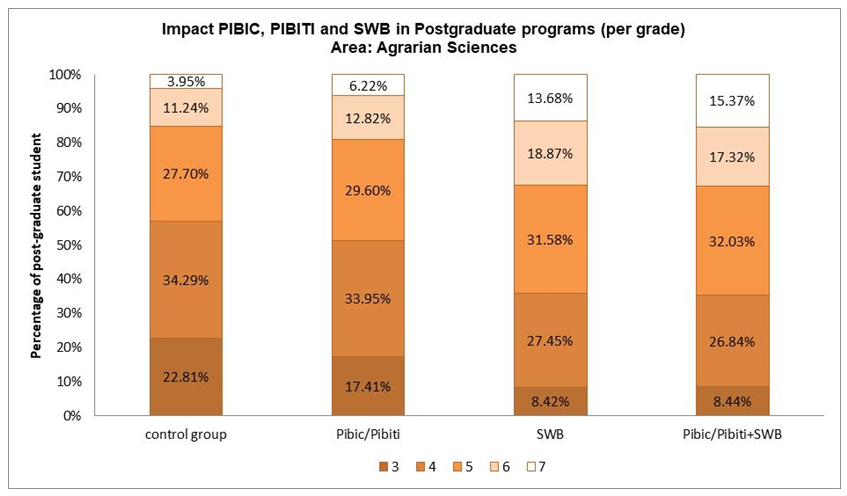 | Figure 3. Percentage of students accessing the Postgraduate Programs. Area: Agrarian Sciences |
 | Figure 4. Percentage of students accessing the Postgraduate Programs. Area: Biological Sciences |
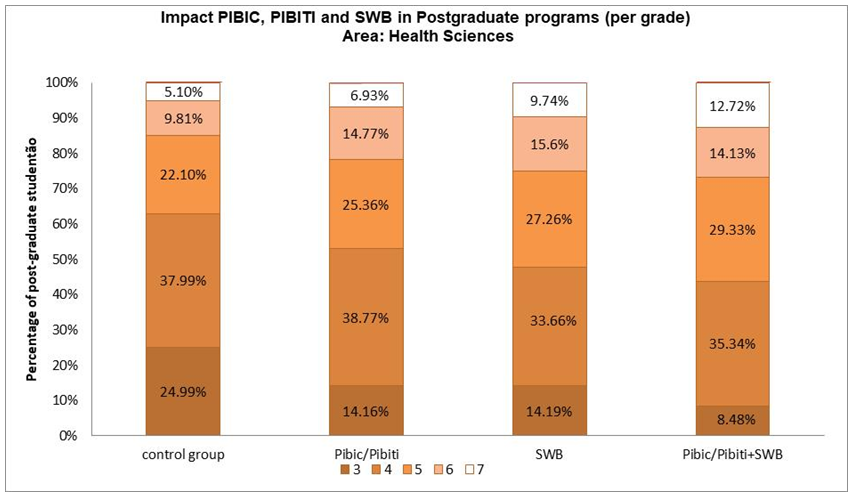 | Figure 5. Percentage of students accessing the Postgraduate Programs. Area: Health Sciences |
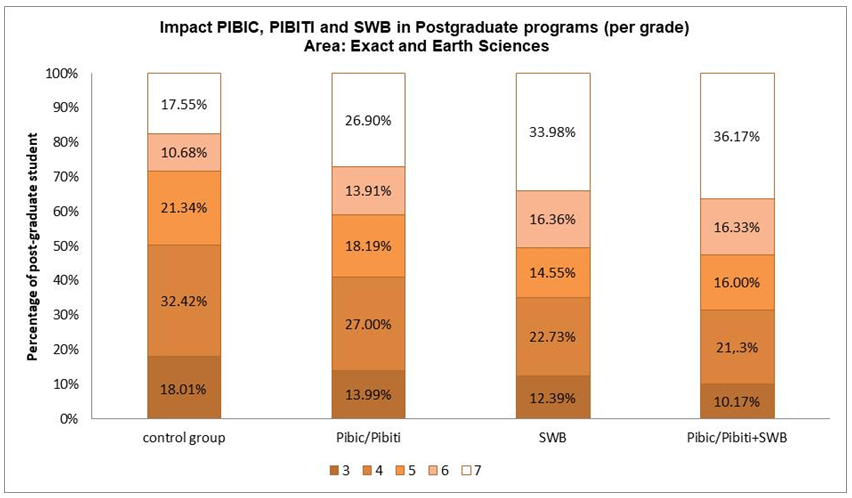 | Figure 6. Percentage of students accessing the Postgraduate Programs. Area: Exact and Earth Sciences |
 | Figure 7. Percentage of students accessing the Postgraduate Programs. Area: Engineering |
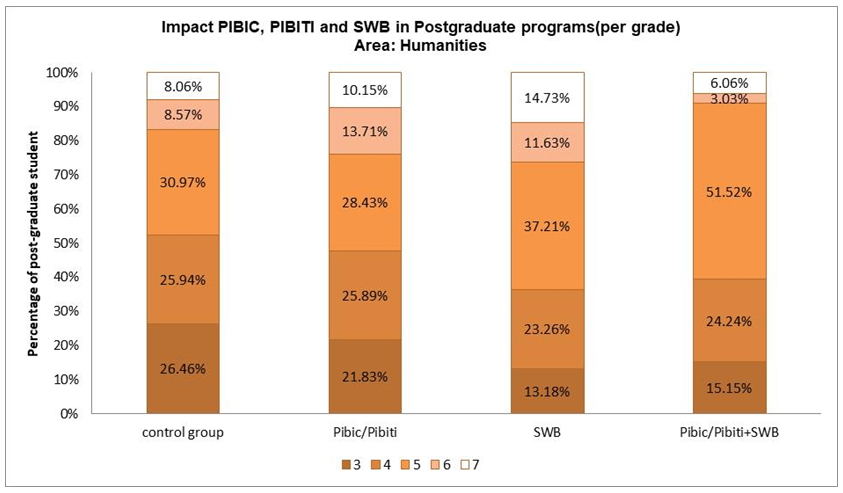 | Figure 8. Percentage of students accessing the Postgraduate programs. Area: Humanities |
 | Figure 9. Percentage of students accessing the Postgraduate Programs. Area: Applied Social Sciences |
 | Figure 10. Percentage of students accessing the Postgraduate Programs. Area: Linguistics, Literature and Arts |
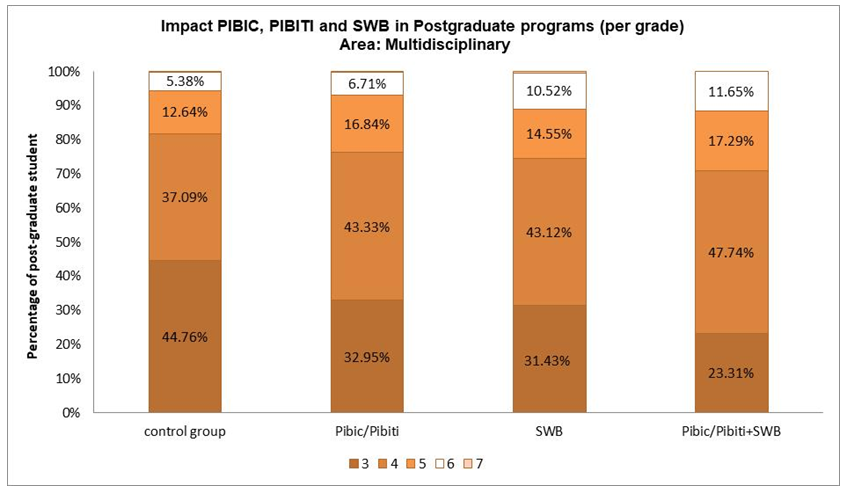 | Figure 11. Percentage of students accessing the Postgraduate Programs. Area: Multidisciplinary |
4. Conclusions
- Observing the presented data and the analyses carried out, it is generally perceived that the undergraduate programs (Pibic/Pibiti) as well as the SWB program contributed greatly to the access of undergraduate students into the postgraduate programs with higher quality and internationalized programs (grades 6 and 7 of the PPGs).Postgraduate Programs of priority areas of SWB. Considering the access into Postgraduate Programs (PPGs) in the areas related as priority by the Science without Borders (SWB) program, it was observed that the participants of the control group (those who did not participate in Pibic/Pibiti or SWB programs) accessed more into Postgraduate Programs grade 3, with a much less (and sometimes vertiginously) access into PPGs of excellence (note 6 and 7). When participating on Pibic/Pibiti or SWB programs, the undergraduate students accessed to a lesser degree PPGs with maturity (grade 3), accessing in higher degree into PPGs with grades to 6 and 7.Postgraduate Programs of non-priority areas of SWB. Considering the access into Postgraduate Programs (PPGs) in the areas related as non-priority by the Science without Borders (SWB) program, a more erratic outcome was observed. Pibic/Pibiti or SWB programs did not cause a tendency to increase the access of undergraduate students to PPGs more qualified, presenting grades 6 and 7. The exception was with PPGs of non-priority Multidisciplinary area, where, although with less intensity, the Pibic/Pibiti or SWB programs also induced a great access of undergraduate students into PPGs grades 4, 5and 6.Therefore, the presented data strongly indicate that Brazilian policies directed to undergraduate students, as “scientific initiation” (Pibic/Pibiti) and scientific international experience during graduation (SWB) substantially contributed subsequent better scientific formation of high-level human resources in Brazilian Postgraduate Programs with quality nationally and internationally recognized as academic excellence.This interaction between the Pibic/Pibiti, SWB and PPGs programs in Brazil can potentially be the basis for potential public policies able to integrate these three programs, which, together, may improve students scientific training, as well as reinforce the interaction between Brazil and the scientific international community, in relevant areas as education, science, technology and innovation.
 Abstract
Abstract Reference
Reference Full-Text PDF
Full-Text PDF Full-text HTML
Full-text HTML